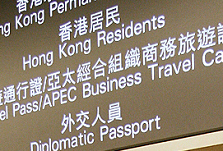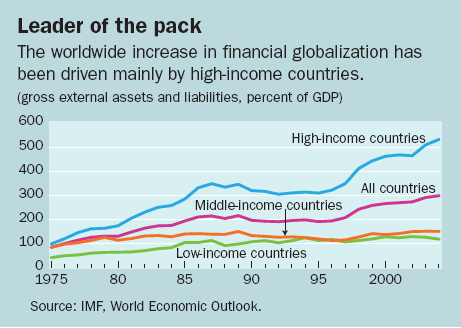
Typical street scene in Santa Ana, El Salvador. (Photo: iStock)
IMF Survey: Who's Driving Financial Globalization?
August 16, 2007
- Financial globalization has approximately tripled since mid-1970s
- Countries' relative success in attracting financial flows is broadly stable over time
- Bilateral gross asset holdings linked to distance, language, former colonial ties
Financial globalization, measured by gross external assets and liabilities relative to a country's GDP, has approximately tripled since the mid-1970s.

Research shows distance, language, former colonial ties still have big influence on global financial flows (photo: Laurent Fievet/AFP)
ATTRACTING FINANCIAL FLOWS
But this increase masks wide regional differences (see chart).
High-income countries account for most of the increase. In low- and middle-income countries, average increases have been more moderate. Within this group, however, there is also substantial variation. Countries in East Asia have, on average, experienced a sixfold increase. Central and Eastern Europe has experienced a threefold increase. This compares with a more modest twofold increase for low- and middle-income countries as a whole.

Countries' relative success in attracting financial flows has remained broadly stable over time. Our research shows that bilateral gross asset holdings are closely associated with factors such as distance, language, and former colonial links.
This finding may seem surprising in a world where information appears to flow freely and where money can go almost anywhere it wants. But our analysis also suggests that these and other factors that hinder the free flow of information can, to some degree, be overcome by improving financial and corporate sector transparency.
How to measure it
How open a country is to investment from abroad can be measured in three different ways:
• Stock measurements. The size of gross stocks of external assets and liabilities is by now the most widely used measure of international financial integration. It is calculated as the sum of gross external assets and liabilities relative to a country's GDP.
• Flow measurements. In a completely closed economy, savings must equal investment. Therefore, one way to calculate financial openness is to calculate the difference between savings and investment flows. In practice, however, this measure has not proved very useful because savings and investment are highly correlated even in countries that seem fully open to capital flows from abroad.
• Price-based measurements. If a country is fully integrated with the world economy, there should be no possibilities for investors and traders to exploit price differences for goods and services. Following this logic, financial openness can also be measured by comparing interest rates, or prospective returns on financial instruments, in different countries.


